MV Agusta Superveloce 1000 Serie Oro Review – First Ride
Beauty is not a sin!
MV Agusta’s planned resurgence under the ownership of Austria’s Pierer Mobility, after the proprietor of KTM, Husqvarna and GASGAS acquired a majority 50.10% stake in Italy’s No.1 trophy marque on March 15 this year, has been triggered by the debut of two distinctive new models conceived under the company’s previous owners, the Russian Sardarov family.
Each is at opposite ends of the price range envisaged for the company under its new Austrian proprietors, with the brand’s debut ADV motorcycle, the three-cylinder 931cc Enduro Veloce launched earlier this year and now in MV dealerships, essentially acting as its entry level model, costing €23,000 in Italy incl. 22% local tax. But right at the other end of the price scale comes the exquisite, exclusive and very expensive Superveloce 1000 Serie Oro, of which just 500 examples will be made costing €70,700 in Italy incl. tax. That makes this exactly the kind of motorcycle which MV’s new owner Stefan Pierer told me that it should, in his opinion, be making. “Where MV Agusta’s coming from, it’s premium high end,” he said. “For me, the model that still captures the essence of MV Agusta is the F4. When it first appeared 25 years ago it had so many nice details – it was perfect, and very beautiful. But I would say that style got lost in the last decade, because they had other problems to worry about. We need to rebuild the company based on this legacy.”
In which case, I’m sure the Superveloce 1000 Serie Oro now finally being built at MV’s lakeside Schiranna factory outside Varese, after debuting in public at the 2022 EICMA Milan Show, more than meets Pierer’s expectations. Powered by MV’s trademark F4 radial-valve four-cylinder inline motor, as its name suggests and its looks clearly infer, this is conceptually based on the seductive, ultra-striking Superveloce 800 triple, a literally unique blend of old and new, retro and avantgarde, classic and modern, which acted as a fitting finale to its creator Adrian Morton’s 16-year stint as MV Agusta’s Design Director which ended in June 2020.
“This is a motorcycle I’ve dreamt of designing for the past ten years, ever since we created the F3 Supersport,” said Morton. “We’ve got one of the most incredible brands in terms of heritage, but we’ve never really pushed that into our styling. So it took one of our customers to make us do that, and we were all very glad he did!” How come? “In 2016 we were approached by a Japanese MV Agusta enthusiast who wanted us to do a one-off concept bike for him, based on one of our existing platforms – he wanted a slightly futuristic neo-retro design. I’d already made sketches of this kind of bike combining classic design cues with modern performance, using the Brutale 800 platform – though I also did some based on the F3. But even if in the end that project didn’t happen, what remained were some ideas for a neo-classic sports model.”
“So when it was decided to do a showbike for the 2018 EICMA Show, I already had several different Superveloce variants on different platforms to choose from,” Morton continued. “I did one on the four-cylinder 1000 platform, one on the Brutale one and one based on the F3, and basically, that’s the one we chose because its fuel tank is a little bit retro in some respects – a bit more Disco Volante in a way than the Brutale tank is. So that’s what we went with, and after winning ‘The Most Beautiful Motorcycle of the Show’ award at EICMA 2018, and first prize in the Concept Bike category the following May at the Villa d'Este Concorso d'Eleganza, it ended up being built.” With all 300 examples of the limited edition Superveloce 800 Serie Oro production run sold out online inside six days at what’s practically a bargain price of €27,990 compared to today’s 1000cc equivalent, a volume production version with only a little less bling at three-quarters of the price followed a year later, and despite its production initially being slowed by MV’s Covid-19 induced 10-week shutdown, has since proved a global hit with customers.
Hence Morton’s then boss Timur Sardarov’s desire to develop a four-cylinder Superveloce 1000, since the commercial success of the 800 triple version made building a bigger, brawnier, one-litre F4-powered version a high priority. But Morton’s departure meant a new designer had to be tasked with that role, French former Honda Japan and GK Design/Yamaha stylist Stéphane Zache who joined MV’s San Marino-based CRC R&D operation in September 2020 as MV’s new Chief Designer. After warming up with the MV Agusta F3 RR, the Enduro Veloce unveiled at EICMA 2021 under the Lucky Explorer label was his next creation, followed a year later by the Superveloce 1000 based on the MV Agusta Brutale 1000 RR platform.
However, producing that obviously wasn’t as easy as simply clothing the Brutale rolling chassis with Superveloce 800 bodywork, so in delivering that bulked-up version of Morton’s iconic original design, Zache has had to go back to first principles, and the result is that most difficult of achievements, designing a bike which looks like its kid sister that was produced by someone else, but is completely different in every respect. Chapeau! as they say in Stéphane’s home nation.... He’s done that while retaining only the distinctive round LED poly-ellipsoidal projector headlamp and rear taillight from the SV 800, the entire rest of the bike being his unique design based on the Brutale 1000RR platform.
“The fact that I had to work with the quite large Brutale fuel tank essentially determined the kind of bike I designed, because I obviously had to integrate it into the styling” says Stéphane Zache. “I’d have preferred designing a new tank that was longer and slimmer, but without that I’ve ended up producing a bike that’s much more aggressive looking than the Superveloce 800. But while inevitably less elegant, I think it has greater presence – it’s a version of that bike on steroids!”
As part of that more assertive appearance and in keeping with today’s generation of Superbikes, Zache has also given his creation wings – a feature very much in keeping with MV’s historical traditions, given that it was the first race team to fit them to a GP bike. That came when reigning World champion Phil Read appeared for practice in the 1974 Belgian GP at Spa with twin front ailerons fitted to his factory 500GP MV Agusta. He never used them in a race – but it pointed the way for MotoGP to follow in MV’s tire tracks 40 years later. “I found a photo of this bike in a book, so I wanted to feature these wings in my design, but to blend them into the shape of the bodywork, not just attach them to it like so many bikes do today,” says Stéphane. “I think the result is more sensual, but also more aggressive.” It’s worth noting that the wings have delivered a claimed 86.4 lbs of extra front wheel downforce at 199 mph in wind tunnel testing, so they’re functional as well as fetching-looking.
Moreover, the Superveloce 1000 is the first one-liter four-cylinder MV Agusta to carry a full fairing since the F4 ceased production six years ago, and despite its neo-retro looks, its performance on paper is comparable with the best of today's one-liter superbikes. That’s because it’s powered by the muscular, mighty 998cc Brutale 1000 RR motor measuring 70 x 50.9 mm, which produces a homologated 208 hp at the crankshaft at 13,000 rpm in Euro 5 compliant form, with meaty peak torque of 86 lb-ft. at 11,000 revs. These impressive numbers come courtesy of a motor that’s safe to the 14,000 rpm limiter (your choice of a hard or a soft cutout), having been designed with a focus on reducing friction and enhancing lubrication at higher revs. The crankcases are machined differently from the old F4 to incorporate an upgraded lubrication system aimed at countering oil surge under the massively enhanced acceleration of the bike. Essentially, what MV Agusta’s R&D team has done is to copy the format of Mike Hailwood’s 1960’s MV Agusta World champion 500GP four, and created an oil reservoir beneath the crankcase. This results in a semi-dry sump engine with reduced oil drag, while at the same time positioning a splitter within the casing to minimise surge, and stop the oil rushing to the back of the crankcase under hard acceleration. The Brutale 1000 RR with the same identical spec motor delivers over 1G when the launch control button on the right handlebar is pressed, en route to an official 2.9 sec 0-100 km/h trap time – with lights and a horn, and Euro 4 compliance. Phew! The only slightly heavier Superveloce Mille surely has comparable performance.
The short-stroke crankshaft carries forged titanium conrods (rather than machined from billet, so even stronger and lighter) made by Oral Engineering in Modena, headed by former Ferrari F1 technical boss Mauro Forghieri. These carry forged three-ring Asso pistons with cast-iron compression rings aimed at reducing friction. The engine also carries a single gear-driven counterbalancer resulting in a claimed reduction in vibration of 54% at 14,000 rpm. The same cylinder head casting as on the old F4 motor has been retained, still with radial valves, but with quite different intake porting and new chain-driven camshafts delivering greater lift and dwell. Additionally, the combustion chambers housing the 31.8mm intake and 26.5mm radial titanium valves have now been machined from solid billet, to deliver a high 13.6:1 compression ratio, a key element in obtaining the bike’s vivid acceleration. Moreover, the all-new Akrapovič stainless steel exhaust features a modern slanted-pipe titanium tribute to the original F4 Tamburini organ’s four tailpipes exiting behind the seat, a characteristic feature of that bike ever since its incarnation.
The Superveloce 1000 also features an ride-by-wire throttle incorporating four riding modes regulated by an IMU inertial platform – Race, Sport, Rain and Custom – which can be selected on the go without closing the throttle. The sophisticated electronic package includes eight-level traction control, two-level engine braking control, on/off anti-wheelie control, a speed limiter, cruise control, three stages of throttle sensitivity, and a two-way quickshifter. But this has involved choosing the specific optimum supplier for each element, then splicing them together under MV’s direction – so the RBW system with a quartet of 50mm throttle bodies is by Mikuni, which also supplies the lower of the two injectors per cylinder, with the upper top-spray injectors from Magneti Marelli. MV’s traditional electronics partner Eldor supplies the Nemo 2.1 ECU, while switchable two-stage Continental MK100 Cornering ABS is installed, incorporating RLM rear wheel lift up control. The six-speed cassette-type extractable gearbox with straight-cut primary drive is matched to an oil-bath slipper clutch.
This by now well-proven 90% new engine that’s equipped the Brutale RR in the same state of tune since it replaced the previous F4 motor in 2020, sits as a fully-stressed component in the SV 1000’s composite chassis. This again is Brutale-sourced, with an upper chrome-moly steel spaceframe connected to twin lower aluminium plates CNC-carved from solid billet. Öhlins electronic suspension is fitted front and rear, with both the 43mm NIX fork and TTX rear shock delivering 120mm of travel via electronically controlled compression and rebound damping, and also spring preload on the shock. This is operated via a variable-rate link by the cast aluminium single-sided swingarm, whose pivot height is adjustable +/-4mm. However, there’s manual preload adjustment on the Superveloce’s fork, which is set at a 23° rake with 3.8 inches of trail, delivering a 55.7-inch wheelbase (versus the Brutale’s 56.4 in.). The damping map also changes according to the rider mode selected, so for example Race has a quite different suspension response than Rain. The Öhlins steering damper is also electronically controlled, but is simply velocity adjustable – so it’s lighter at low speeds in town, automatically becoming progressively stiffer as speed rises up to the 180 mph mark.
The distinctive 17-inch forged aluminium wheels are inspired by the stylised star-shaped ones featured on the original 1998 MV Agusta F4 750 Serie Oro, but here come with red tubular steel bracing spokes. At 3.50-inches in the front and 6.00 inches in the rear, these carry red-striped Diablo Supercorsa SP V4 tires specially developed by Pirelli for the bike, a 120/70 front and 200/55 rear. Brembo’s Stylema four-piston Monoblock brake calipers are fitted up front, gripping 320mm floating discs with their flanges aerodynamically sheathed in carbon fiber, with a twin-piston Brembo caliper and 220mm rear disc combo. This powerful brake package is managed by the Continental ABS system with two different levels of intervention depending on the chosen riding mode. In Sport mode, the ABS acts on both wheels with the cornering function and RLM both active. In Race mode, the ABS intervention is less invasive at the front, and is deactivated at the rear, same as the cornering function, while the RLM system remains active, but allows for a controlled lift of the rear wheel.
Those wheel covers are just two of the 41 different carbon fiber components, both forged and laminated, on this exquisitely detailed motorcycle, including all the bodywork save for the thermoplastic fuel tank. Together with the copious titanium fasteners this helps deliver a kerb weight of 456 pounds including a full 4.2 gallon fuel tank (427 lbs dry) – just 24 pounds heavier than the naked Brutale it shares its engine and chassis with, despite all the extra bodywork. The 5.5-inch TFT color dash with Bluetooth connectivity has two different available background colours and a choice of two displays, with an integrated GPS module that communicates directly with the MV Ride app, and allows you to obtain turn-by-turn directions to your chosen destination straight to the TFT display. Activating Trip Record initiates data acquisition which then allows you to relive your ride, including the complete route, speed, gear used, lean angle, altitude, and travel times. You can also upload the route and related data to the MV Ride App. This also allows you to customise the bike's various settings via the Custom ride mode, which can then be stored and even exchanged with others.
As with every MV Agusta limited edition model, the Superveloce 1000 Serie Oro customer receives a dedicated kit of goodies for his/her bike. This includes a certificate of authenticity, a cover, a passenger seat in leather and Alcantara (same as the solo seat), passenger footpegs and supports, carbon passenger heel guards, CNC-machined brake and clutch levers and height adjustment plates for the swingarm pivot.
Available only in a metallic scarlet and silver version of MV’s traditional race colours, production of this mechanical symphony of art coupled with high-end engineering has now begun, so I had the chance to spend a hot 90° Italian summer’s day riding one of the first bikes off the production line in an attempt to answer the all-important question: is the Superveloce 1000 even remotely as much fun to ride as it is gorgeous to look at?
The fully adjustable footrests made it easy for me to get comfortable on the bike for a 90-mile full day’s fang following my old mate, MV’s factory tester Andrea Rossignoli on the bare carbon muletto test bike around the hills and lakes of northern Italy – including his top secret venues for high-speed testing. First, though, before standing on tiptoe at 5’10” in height to climb aboard the MV’s 33.3 inch-high seat, it’s impossible to do so without spending a few reflective seconds checking out what it is you’re about to throw a leg over. I mean, this bike completely lives up to MV’s mantra of Motorcycle Art, and just as you wouldn’t just hop into a Ferrari Enzo T140 or a Bugatti Veyron as if it were your own Fiat 500 without taking a moment to savor the experience, the same goes for the Superveloce 1000. Just walking into the MV factory yard to see it glistening in the sunshine while awaiting my pleasure resulted in a sharp intake of breath – and without being too pleased with myself, I have ridden a few pretty nice ultrabikes in the past 40 years, so I’m not too easily impressed. But just as its creator Stéphane Vache told me – this bike has presence.
It also delivers a great soundtrack from the 2024 version of the Tamburini organ when you press the starter button – even if it’s not quite as musical as its sister instrument in the MV orchestra, the Enduro Veloce triple that’s very possibly the best-sounding Euro 5+ compliant motorcycle yet built. But the screamer firing order of the Superveloce’s four-cylinder inline motor lives up to its name at higher revs, defined as anywhere over 7,000 rpm, so the top half of the rev range. Okay, it’s inevitably more muted than the first F4 750 was on its marketplace debut 25 years ago – was it really that long ago?! – but it still lives up to the expectations aroused by that badge on the bodywork. Čestitke, Igor Akrapovič!
Once aboard the surprisingly welcoming and well-padded seat, for something this sporty, the Superveloce’s riding position wasn’t what I was expecting, which I suppose comes from its Brutale ancestry. It’s quite a balanced stance, without undue weight on your wrists and shoulders, and although the sweptback screen is too low to be able to really tuck away behind it, I was able to make a decent stab at doing so along some of the faster stretches of Andrea’s Racer Road, and you do feel you’re sitting more within the bike than perched atop it, like on the F4. The clip-ons have been raised 1.4 inches compared to that bike, and the default footrest location is 2.8 inches lower albeit still quite far back, so you’ve got a much more spacious stance which is ultimately less tiring. The Superveloce 1000 is improbably comfortable for this fast a bike.
Still, nervous energy consumes you for the first half hour aboard this motorcycle, trying desperately hard not to risk damaging something this valuable and beautiful in morning Varese rush hour traffic as I followed Andrea in cutting a carefree course – well, for him maybe – out of town in the direction of the Alps. Though the clutch lever felt pretty stiff when using it repeatedly in stop-n-go situations, once I got the revs up and started going faster, I soon revelled in the absolutely faultless two-way quickshifter. Just like on the Enduro Veloce I’d ridden earlier, this is perfectly set up to deliver a seamless gear change each and every time – it’s light in action, but also positive, the best of both worlds, as befits the company which has a longer experience of fitting this to their road bikes than anyone else. MV’s latest clutchless gearshift was already promising when I rode the Brutale RR four years ago, and the Rush after that, but now it’s perfect. It’s not too sensitive, so you must do more than just brush your boot against the lever and need to make a decisive movement, but the cutout duration is infinitesimal, and the gearshift perfect in both directions.
The ratios it selects are also well chosen, with third gear especially ideal for holding for mile after mile on twisting mountain roads, as I let the engine soar from as low as 3,500 rpm where meaningful power starts being delivered, up to somewhere approaching the 14,000 rpm rev limiter which on the 41/15T final drive gearing means well over the ton – in third gear! Okay, I’ll admit I did that just out of curiosity – but back in the real world when I spent most of my 90 mile day on the Superveloce, I found this ultra-powerful engine package to be astonishingly easy to ride relatively slowly, just cruising along at 60 mph or so – it was perfectly happy to be short-shifted at around 6,000 rpm. The low down fuelling is really excellent, and aided by the easy-shifting clutchless transmission there’s pretty decent performance anywhere below 7,000 rpm, which is the gateway to the ‘Veloce’ part of the bike’s name.
There isn’t exactly a step in the power curve, but from that point onwards, the four-cylinder motor begins picking up revs in an increasingly frenzied manner, and you must tense yourself to hold on tight as the MV lunges forward like a guided missile if you gas it wide open. The anti-wheelie software does its job, especially in Race mode where the throttle response is lightning fast, and with level 3 TC (level 1 being the least intervention) selected the rear Supercorsa hooked up well on the granite-filled tarmac of those Alpine roads. Flexible and forgiving low down, just show the Superveloce 1000 a stretch of open road, and it rockets away from a standing start, while fifth gear roll-on from 75 mph was really responsive – sorry, I couldn’t find room to use top gear properly! You do feel a step in the power delivery at 9,500 rpm, when it seems the acceleration kicks in even harder. This is unbelievably exhilarating to experience – yet all achieved with minimal vibration at any revs, thanks to the effective gear-driven counterbalancer installed.
So powering through the gears and shifting at 11,500 rpm delivers warp factor acceleration – but the Superveloce goes round corners well, too. It’s very stable round fast sweepers, though I got increasingly aware as the day wore on of the way that wide 200-section rear tire heavied up the steering. The Superveloce is reasonably sharp steering, but you have to work hard at flicking it from side to side through successive second/third-gear mountain turns, and on such a hot day I freely admit it got tiring. But it’s pretty forgiving – you can make an error of judgement with your turn speed halfway round a bend, finger the front brake lever to cram off a little speed, and the MV just slows, without sitting up and heading for the hedges. Yet get your judgement right, and it sails round turns one gear higher than you might have expected, the front Pirelli glued to the track surface, and the Öhlins suspension working in perfect concert. The engine mapping is ideal in both Sport and Race modes, and though throttle response is notably more aggressive in the latter, pickup from a closed throttle is strong rather than snatchy, and you feel a sense of control that’s very welcome with such a potent package. As always the Brembo Stylema calipers had excellent feel and feedback, and the Continental ABS did its job in minimizing rear wheel lift even with my body weight thrown forward onto the front wheel under that awesome stopping power, with the engine braking still providing some welcome assistance via the slipper clutch as I backed down the gears seamlessly and clutchlessly.
Dripping with desirability, the Superveloce 1000 is as enticing to ride as it is to look at. Its creation has restored MV Agusta to its previous pedestal as the maker of the most alluring and enticing high-performance motorcycles money can buy – but at a price which is certain to ensure its exclusivity. However, just as with its 800 kid sister and all other Serie Oro MV models, we’re certain to see a less costly Normale version in 2025, and I for one can’t wait to ride that. MV Agusta’s publicity mantra is ‘Motorcycle Art’, and just like its 800 junior version the Superveloce 1000 epitomizes that motto. While entirely living up to its looks, and name, it’s also fun to ride, and rewarding to do so, too. This is a very clever bike, both stylistically and dynamically, and it’s very unlikely that anyone who buys one will be disappointed by the experience of owning one, and riding it. Apart from anything else, it’s a people magnet. Every time I stopped onlookers would surround it, eager for a selfie with this two-wheeled piece of Italian art. Stand in line, folks....!
2024 MV Agusta Superveloce 1000 Serie Oro Specifications | |
|---|---|
Engine Type | Liquid-cooled four-stroke Inline-Four with 16 valves, DOHC |
Displacement | 998cc |
Bore x Stroke | 79.0 mm x 50.9 mm |
Compression Ratio | 13.4:1 |
Starter | Electric |
Horsepower | 208 hp at 13,000 rpm (claimed) |
Torque | 86 lb-ft. At 11,000 rpm (claimed) |
Electronics | MVICS 2.1 (Motor & Vehicle Integrated Control System) with eight injectors (4 lower fuel injectors by Mikuni + 4 upper fuel injectors by Mikuni with increased fuel flow). Engine control unit Eldor Nemo 2.1, throttle body bore 50 mm diameters full ride by wire Mikuni, pencil-coil with ion-sensing technology, control of detonation and misfire. Torque control with four maps. Traction control with 8 levels + off and wheelie control with inertial platform |
Clutch | Wet, multi-plate with back torque limiting device and Brembo radial pump/lever assembly |
Transmission | Cassette style six-speed constant mesh gearbox, with MV EAS 4.0 (Electronically Assisted Shift Up & Down) |
Final Drive | Chain, 14/41 ratio |
Frame | High resistance steel tubular trellis frame with aluminum alloy rear swingarm pivot plates and adjustable swingarm pivot height. |
Steering Damper | Öhlins EC with electronic manual and automatic adjustment modes |
Front Suspension | Öhlins Nix EC hydraulic 43mm inverted front forks with TiN superficial treatment. Completely adjustable with electronically controlled compression and rebound damping with manually controlled spring preload; 4.7 inches of travel. |
Rear Suspension | Progressive, single shock absorber Öhlins EC TTX completely adjustable with electronically controlled compression and rebound dampingnd spring preload; 4.7 inches of travel. |
Front Brakes | Dual Brembo Stylema radial-mount monoblock four-piston calipers with 320 mm discs, Brembo radial pump/level assembly. |
Rear Brakes | Brembo two-piston caliper with 220mm disc, Brembo PS13 brake master cylinder. |
ABS | Continental MK100 with RLM (Rear Wheel Lift-up Mitigation) and with cornering function |
Front Wheel | Aluminum alloy 3,50” x 17” |
Rear Wheel | Aluminum alloy + spokes 6,00” x 17” |
Front Tire | 120/70 - ZR 17 M/C (58 W) |
Rear Tire | 200/55 - ZR 17 M/C (78 W) |
Rake/Trail | 23°/3.8 inches |
Wheelbase | 55.7 inches |
Length | 81.9 inches |
Width | 35.2 inches |
Seat Height | 33.3 inches |
Ground Clearance | 4.3 inches |
Weight | 460.7 pounds (claimed, without fuel) |
Fuel Capacity | 4.2 gallons |
Become a Motorcycle.com insider. Get the latest motorcycle news first by subscribing to our newsletter here.
A man needing no introduction, Alan Cathcart has ridden motorcycles since age 14, but first raced cars before swapping to bikes in 1973. During his 25-year racing career he’s won or been near the top in countless international races, riding some of the most revered motorcycles in history. In addition to his racing resume, Alan’s frequently requested by many leading motorcycle manufacturers to evaluate and comment on their significant new models before launch, and his detailed feature articles have been published across the globe. Alan was the only journalist permitted by all major factories in Japan and Europe to test ride their works Grand Prix and World Superbike machines from 1983 to 2008 (MotoGP) and 1988 to 2015 (World Superbike). Winner of the Guild of Motoring Writers ‘Pierre Dreyfus Award’ twice as Journalist of the Year covering both cars and bikes, Alan is also a six-time winner of the Guild’s ‘Rootes Gold Cup’ in recognition of outstanding achievement in the world of Motorsport. Finally, he’s also won the Guild’s Aston Martin Trophy in 2002 for outstanding achievement in International Journalism. Born in Wales, married to Stella, and father to three children (2 sons, 1 daughter), Alan lives in southern England half an hour north of Chichester, the venue for the annual Goodwood Festival of Speed and Goodwood Revival events. He enjoys classic cars and bikes, travel, films, country rock music, wine - and good food.
More by Alan Cathcart























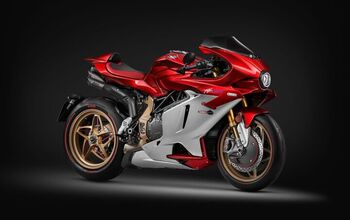


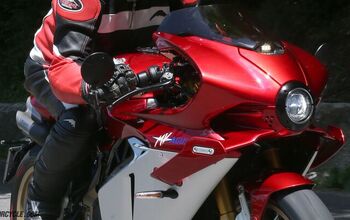




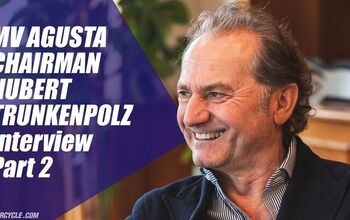



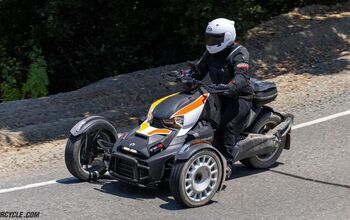


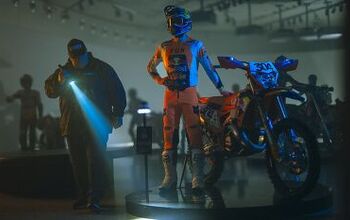
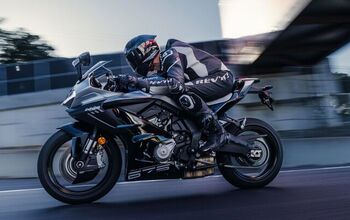

Comments
Join the conversation
One homely looking motorcycle from the tank on back.
This isn't retro design, it's just good design.
Ditti the new Moto Guzzi V100s, the Z900RSs, the Indian Scouts, the Harley-Davidson Softails and the Triumph Bonnevilles.
Some things don't need to change, just improve!